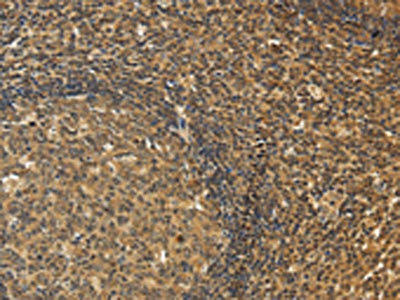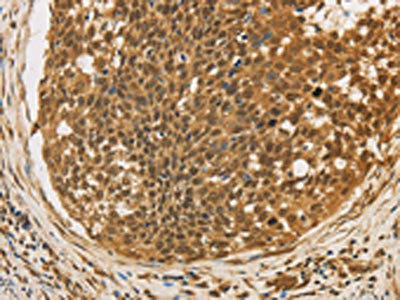Description
| Antibody Name: | CXXC5 Antibody (PACO16092) |
| Antibody SKU: | PACO16092 |
| Size: | 50ul |
| Host Species: | Rabbit |
| Tested Applications: | ELISA, WB, IHC |
| Recommended Dilutions: | ELISA:1:2000-1:5000, WB:1:200-1:1000, IHC:1:50-1:200 |
| Species Reactivity: | Human, Mouse, Rat |
| Immunogen: | Fusion protein of human CXXC5 |
| Form: | Liquid |
| Storage Buffer: | -20°C, pH7.4 PBS, 0.05% NaN3, 40% Glycerol |
| Purification Method: | Antigen affinity purification |
| Clonality: | Polyclonal |
| Isotype: | IgG |
| Conjugate: | Non-conjugated |
 | The image on the left is immunohistochemistry of paraffin-embedded Human tonsil tissue using PACO16092(CXXC5 Antibody) at dilution 1/20, on the right is treated with fusion protein. (Original magnification: x200). |
 | Gel: 8%SDS-PAGE, Lysate: 40 μg, Lane: Mouse brain tissue, Primary antibody: PACO16092(CXXC5 Antibody) at dilution 1/200, Secondary antibody: Goat anti rabbit IgG at 1/8000 dilution, Exposure time: 1 minute. |
 | The image on the left is immunohistochemistry of paraffin-embedded Human cervical cancer tissue using PACO16092(CXXC5 Antibody) at dilution 1/20, on the right is treated with fusion protein. (Original magnification: x200). |
| Background: | CXXC5 (CXXC finger 5), also known as RINF or HSPC195, is a 322 amino acid, protein that localizes to both the nucleus and the cytoplasm and contains one CXXC-type zinc finger. Interacting with Dvl-1, CXXC5 acts as a mediator of Wnt signaling in neural stem cells and is thought to participate in the activation of MAP kinase pathways. The gene encoding CXXC5 maps to human chromosome 5 and is expressed as multiple alternatively spliced isoforms. |
| Synonyms: | CXXC finger protein 5 |
| UniProt Protein Function: | CXXC5: May indirectly participate in activation of the NF- kappa-B and MAPK pathways. Acts as a mediator of BMP4-mediated modulation of canonical Wnt signaling activity in neural stem cells. Required for DNA damage-induced ATM phosphorylation, p53 activation and cell cycle arrest. Involved in myelopoiesis. 2 isoforms of the human protein are produced by alternative splicing.Chromosomal Location of Human Ortholog: 5q31.2Cellular Component: cytoplasm; nucleoplasmMolecular Function: protein binding; sequence-specific DNA binding; signal transducer activity; transcription factor bindingBiological Process: negative regulation of transcription from RNA polymerase II promoter; positive regulation of I-kappaB kinase/NF-kappaB cascade |
| UniProt Protein Details: | |
| NCBI Summary: | The protein encoded by this gene is a retinoid-inducible nuclear protein containing a CXXC-type zinc finger motif. The encoded protein is involved in myelopoiesis, is required for DNA damage-induced p53 activation, regulates the differentiation of C2C12 myoblasts into myocytes, and negatively regulates cutaneous wound healing. Several transcript variants encoding the same protein have been found for this gene. [provided by RefSeq, Nov 2015] |
| UniProt Code: | Q7LFL8 |
| NCBI GenInfo Identifier: | 167011303 |
| NCBI Gene ID: | 51523 |
| NCBI Accession: | Q7LFL8.1 |
| UniProt Secondary Accession: | Q7LFL8,Q8TB79, Q9NV51, Q9P0S8, B3KND0, C8CBA8 |
| UniProt Related Accession: | Q7LFL8 |
| Molecular Weight: | 24,072 Da |
| NCBI Full Name: | CXXC-type zinc finger protein 5 |
| NCBI Synonym Full Names: | CXXC finger protein 5 |
| NCBI Official Symbol: | CXXC5 |
| NCBI Official Synonym Symbols: | CF5; WID; RINF; HSPC195 |
| NCBI Protein Information: | CXXC-type zinc finger protein 5 |
| UniProt Protein Name: | CXXC-type zinc finger protein 5 |
| UniProt Synonym Protein Names: | Putative MAPK-activating protein PM08; Putative NF-kappa-B-activating protein 102; Retinoid-inducible nuclear factor; RINF |
| Protein Family: | CXXC-type zinc finger protein |
| UniProt Gene Name: | CXXC5 |
| UniProt Entry Name: | CXXC5_HUMAN |






